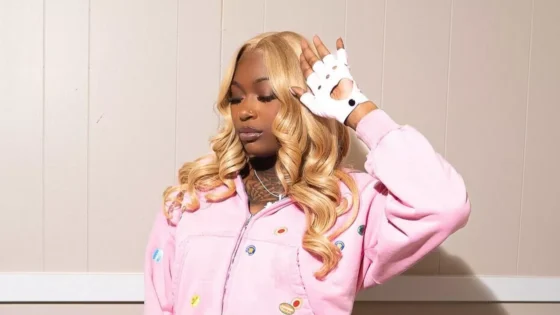Ironically, the only thing Fashionista makes explicit is a debt of influence owed to the work of famously form-bending director Nicholas Roeg, who is honored with a pre-credits title card. The rest of Simon Rumley’s film, about a woman who descends into madness after discovering her husband’s infidelity, is a consciously incoherent string of images composing an unsettling portrait of a woman coming apart at the seams.
About that woman: April (Amanda Fuller) co-owns a vintage clothing store in Austin with her husband, Eric (Ethan Embry), and the two live in an adjacent apartment positively buried in excess inventory. April’s bedroom, bathroom, and office are draped in second-hand clothes, and she appears early in the film to have a fixation with treating her body similarly. When she jealously watches her husband flirt with other women, she nervously massages the fabric of her dress; later in the film, she handles a string of traumas by smelling the clothes (more like huffing, really), or compulsively changing her outfit.
From the start, Fashionista asks the question of who exactly April is dressing for — and what perceived deficiencies she treats with clothing. Jarred by her husband’s wandering eyes, she attempts to seduce him in lingerie; when he resists, she tearfully (and hypothetically) asks a hip, homeless busker if he’d fuck her. When she leave Eric and begins dating Randall (Eric Balfour), a mysterious and controlling business man, she adopts the cosmopolitan look that he desires. Throughout the film, April appears to view herself solely through the eyes of others, which helps explain her psyche fracturing alongside her closest relationship.
April is molded by the people she befriends, desires, loves, and hates, but Fashionista remains focused squarely on the acute affects relationships have on her. When the men in her life sneak around, we don’t know where they go unless April follows; when she remains home, we watch her worry alone. In scenes like these, Rumley’s camera fixates closely on April’s face and body, usually while she gazes into the mirror or languishes in bed. In some of these instances, a sense of surreality encroaches, as shots of her sleeping fitfully are sped up to achieve a hectic, almost transcendent effect — the first hints that April may not be a wholly reliable narrator.
Laser focus on April and the images she perceives and projects allows Rumley to ground this psychological thriller with a harrowing illustration of body dysmorphia and depression — especially late in the film, when we learn that April’s vision of herself might differ drastically from reality. Even after she finds herself witness to a bone-chilling murder later on, the most persistent source of anxiety in Fashionista comes from April’s fraught view of herself, and her willingness to acquiesce to Randall’s most toxic demands so that she may earn his acceptance.
When April shares a room with her husband or her creepy boyfriend, Rumley employs painterly mid-shots that allow us to see her reactions, framing her as an extension of the men in her life. We sense the suffocation of her marriage as April and Eric share a bed with mountains of clothes; her boyfriend’s psychopathy becomes apparent in conversations held in his coldly modern apartment (Patrick Bateman would love the place).
However, the experience of watching Fashionista can only truly be conveyed through the film’s use of montage. The narrative is non-linear, although not in the easily digestible fashion of say Tarantino or Soderbergh; it’s more that in Fashionista — the future bleeds into the present. Extended, coherent scenes exist in the film, but they are connected by jarring snapshots provided entirely without context. Those images, which abruptly intrude on the film’s trackable sequences, are revealed later as part of a larger pivotal moment, and once we understand Rumley’s pattern, they keep us actively attempting to predict April’s fate.
To further complicate things, there is a confounding simultaneous storyline: the film periodically checks in with a mystery woman being released from a mental hospital. You don’t so much watch Fashionista as you are propelled by it, as though the film itself is dragging you along. Events do eventually come to clarify the importance of the mental hospital arc, but the twist doesn’t totally allow us to trust that everything we see in Fashionista is real. Third act gymnastics make it nearly impossible to discuss the film without spoiling Rumley’s big reveal, yet the sensation of watching Fashionista is more potent than the specifics of its twist ending. Rumley’s use of non-linearity imprints images in the viewer’s brain that remain long after the finale: April in grotesque clown makeup; her boyfriend’s staging of a horrifying murder “game;” April cathartically burning a mountain of clothes.
The true accomplishment of Fashionista is the way that it sears these disquieting images into our memory, precisely because it never fully coheres. Rumley’s confounding vision asks for our engagement, and makes us complicit in following April’s thread until the end — even when we don’t want to see what’s next.































